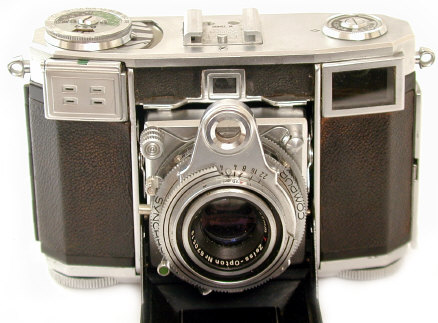 Zeiss Contessa 35
Zeiss Contessa 35Home Camera Articles FOR SALE Orders I Buy / Wants Repairs Books Adapters
 Zeiss Contessa 35
Zeiss Contessa 35
A Real Jewel of a Folding 35
What sets this rangefinder camera off is its very high craftsmanship and finish, much better IMHO than the more expensive and larger Retina IIIC.
The Contessa has lots of old fashioned little gizmos and do-dads, the very antithesis of today's gag me with a computer chip plastic everything wonders.
The pictures really don't do the camera justice. You really have to see one in great condition to appreciate its high quality finish. Be careful though. If you do, you may never look at a modern camera quite in the same way again. The Contessa is wonderfully finished and beautifully over-engineered, a proud product of Zeiss. By modern standards the Contessa's 45/2.8 Zeiss Tessar is still a fine performer, but I would forget about the built in selenium meter, even if it works.
The earlier version (1950-53) has a Compur Rapid shutter and X sync. This one has the later (1953-1955) Synchro Compur shutter and MX sync. Make sure the flash sync is on "X" for electronic flash, unless you are shooting flash bulbs at "M." The RF/VF was good for its time, but rather small by today's standards. There are no projected brightlines, not to mention parallax correction. Incredibly, even the INSIDE of the folding front door is well finished. My oh MY, I haven't seen this much chrome and brass since my father's beloved 1957 Mercury Turnpike Cruiser. The Contessa and the Voigtlander Vitessas compete in my eyes for the honor of "best made" folding 35.
Generically classified as a "folder," the Contessa can fold up compactly. Note the manually set film counter on the baseplate, and the bottom knob film advance or rewind. Open the camera by pulling down on the knob on the front door. Close the camera by pushing in slightly by pushing inward on the front door braces. To rewind the film, push inward on the center button of the film advance knob, while rotating the film rewind knob.
The OUTER knurled ring near the lens front element controls the rangefinder focus. The shutter is manually cocked by pushing downward on the small knurled knob near the PC sync. The shutter speeds are changed by the middle knurled ring near the PC sync, using the indent to select the speed. IMPORTANT: ONLY change the speed to 1/500th BEFORE the shutter is cocked. You may break the shutter if you do otherwise. The f/stops are set by rotating the inner knurled ring next to the camera body, on the camera's left side. The large knurled knob is the shutter release.
In the early '50s it was a sign of advanced engineering to have a built in selenium meter like this one. Fifty years later it is viewed as a disadvantage, as the selenium cells have died long ago or become inaccurate. The light shield goes up in low light, down in bright light.
The film counter is manually set, and not so conveniently located on the camera baseplate. The shutter has a film interlock, which are the gears in the 2nd pic. Running film thru it allows the shutter to be fired, AFTER you have manually cocked the shutter. Or, you can open the back and turn those gears with your fingers, tricking the film lock to allow you to trip the shutter without film.
It's less expensive competitor, the Kodak Retina IIa, was not as well finished, but far better designed to make it a better, faster picture taker.
Compact 35 Rangefinders: the Kodak Retina IIa, Canon QL-17 GIII, and Zeiss Contessa
Home Camera Articles FOR SALE Orders I Buy / Wants Repairs Books Adapters
Revised: November 25, 2003 . Copyright � 1998-2002 Stephen Gandy. All rights reserved. This means you may NOT copy and re-use the text or the pictures in ANY other internet or printed publication of ANY kind. Information in this document is subject to change without notice. Other products and companies referred to herein are trademarks or registered trademarks of their respective companies or mark holders.